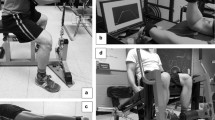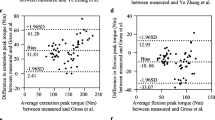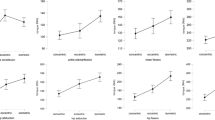Abstract
The main objective of this study was to establish normative values for maximal concentric isokinetic strength and maximal isometric strength of all major muscle groups in healthy subjects applying sex, age, height, and body mass-adjusted statistical models. One hundred and seventy-eight (178) (93 male and 85 female) healthy non-athletic Danish volunteers aged 15–83 years were recruited. Eighteen test protocols for each sex were applied to determine isokinetic and isometric muscle strength at knee, ankle, hip, shoulder, elbow, and wrist using a dynamometer (Biodex System 3 PRO). Multiple linear regressions were performed with maximal muscle strength (peak torque) as dependent variable and age, height, and body mass as independent variables. Muscle strength significantly related to age in 24, to height in 13 and to body mass in 27 out of the 36 models. In gender-specific analyses, the variables age, height and body mass accounted for 25% (20–29) (95% confidence interval) of the variation (r 2) in strength for men and 31% (25–38) for women. The r 2 was similar for the isokinetic models and the isometric models [31% (22–40) vs. 28% (23–34)]. Age, height, and body mass related to strength in most muscle groups and gender-specific models with estimated prediction intervals were established for maximal strength of major muscle groups.

Similar content being viewed by others
References
Aadahl M, Jorgensen T (2003) Validation of a new self-report instrument for measuring physical activity. Med Sci Sports Exerc 35(7):1196–1202
Andersen H (1996) Reliability of isokinetic measurements of ankle dorsal and plantar flexors in normal subjects and in patients with peripheral neuropathy. Arch Phys Med Rehabil 77(3):265–268
Andersen H, Jakobsen J (1997) A comparative study of isokinetic dynamometry and manual muscle testing of ankle dorsal and plantar flexors and knee extensors and flexors. Eur Neurol 37(4):239–242
Baron R (1995) “Normative data for muscle strength in relation to age, knee angle and velocity”. Wien Med Wochenschr 145(22):600–606
Beggs AH, Byers TJ, Knoll JH, Boyce FM, Bruns GA, Kunkel LM (1992) Cloning and characterization of two human skeletal muscle alpha-actinin genes located on chromosomes 1 and 11. J Biol Chem 267(13):9281–9288
Borges O (1989) Isometric and isokinetic knee extension and flexion torque in men and women aged 20–70. Scand J Rehabil Med 21(1):45–53
Cahalan TD, Johnson ME, Liu S, Chao EY (1989) Quantitative measurements of hip strength in different age groups. Clin Orthop Relat Res 246:136–145
Falkel J (1978) Plantar flexor strength testing using the cybex isokinetic dynamometer. Phys Ther 58(7):847–850
Gadeberg P, Andersen H, Jakobsen J (1999) Volume of ankle dorsiflexors and plantar flexors determined with stereological techniques. J Appl Physiol 86(5):1670–1675
Gerdle B, Fugl-Meyer AR (1986) Prediction of peak torque and contraction work at different isokinetic angular velocities of plantarflexion. Eur J Appl Physiol Occup Physiol 55(4):436–439
Gross MT, McGrain P, Demilio N, Plyler L (1989) Relationship between multiple predictor variables and normal knee torque production. Phys Ther 69(1):54–62
Hakkinen K, Kraemer WJ, Kallinen M, Linnamo V, Pastinen UM, Newton RU (1996) Bilateral and unilateral neuromuscular function and muscle cross-sectional area in middle-aged and elderly men and women. J Gerontol A Biol Sci Med Sci 51(1):B21–B29
Kannus P (1994) Isokinetic evaluation of muscular performance: implications for muscle testing and rehabilitation. Int J Sports Med 15(Suppl 1):S11–S18
Keating JL, Matyas TA (1996) The influence of subject and test design on dynamometric measurements of extremity muscles. Phys Ther 76(8):866–889
Larsson L, Grimby G, Karlsson J (1979) Muscle strength and speed of movement in relation to age and muscle morphology. J Appl Physiol 46(3):451–456
Lek M, Quinlan KG, North KN (2010) The evolution of skeletal muscle performance: gene duplication and divergence of human sarcomeric alpha-actinins. Bioessays 32(1):17–25
Lindle RS, Metter EJ, Lynch NA, Fleg JL, Fozard JL, Tobin J, Roy TA, Hurley BF (1997) Age and gender comparisons of muscle strength in 654 women and men aged 20–93 yr. J Appl Physiol 83(5):1581–1587
Lynch NA, Metter EJ, Lindle RS, Fozard JL, Tobin JD, Roy TA, Fleg JL, Hurley BF (1999) Muscle quality. I. Age-associated differences between arm and leg muscle groups. J Appl Physiol 86(1):188–194
Mills M, Yang N, Weinberger R, Vander Woude DL, Beggs AH, Easteal S, North K (2001) Differential expression of the actin-binding proteins, alpha-actinin-2 and -3, in different species: implications for the evolution of functional redundancy. Hum Mol Genet 10(13):1335–1346
Neder JA, Nery LE, Shinzato GT, Andrade MS, Peres C, Silva AC (1999) Reference values for concentric knee isokinetic strength and power in nonathletic men and women from 20 to 80 years old. J Orthop Sports Phys Ther 29(2):116–126
Overend TJ, Cunningham DA, Kramer JF, Lefcoe MS, Paterson DH (1992) Knee extensor and knee flexor strength: cross-sectional area ratios in young and elderly men. J Gerontol 47(6):M204–M210
Sapega AA, Nicholas JA, Sokolow D, Saraniti A (1982) The nature of torque “overshoot” in Cybex isokinetic dynamometry. Med Sci Sports Exerc 14(5):368–375
Stalberg E, Borges O, Ericsson M, Essen-Gustavsson B, Fawcett PR, Nordesjo LO, Nordgren B, Uhlin R (1989) The quadriceps femoris muscle in 20–70-year-old subjects: relationship between knee extension torque, electrophysiological parameters, and muscle fiber characteristics. Muscle Nerv 12(5):382–389
Acknowledgments
Lotte Faarbaek and Holger Kiilerich are acknowledged for their skilled technical assistance.
Conflict of interest
The authors report no conflicts of interests.
Author information
Authors and Affiliations
Corresponding author
Additional information
Communicated by Jean-René Lacour.
Electronic supplementary material
Below is the link to the electronic supplementary material.
Rights and permissions
About this article
Cite this article
Harbo, T., Brincks, J. & Andersen, H. Maximal isokinetic and isometric muscle strength of major muscle groups related to age, body mass, height, and sex in 178 healthy subjects. Eur J Appl Physiol 112, 267–275 (2012). https://doi.org/10.1007/s00421-011-1975-3
Received:
Accepted:
Published:
Issue Date:
DOI: https://doi.org/10.1007/s00421-011-1975-3




